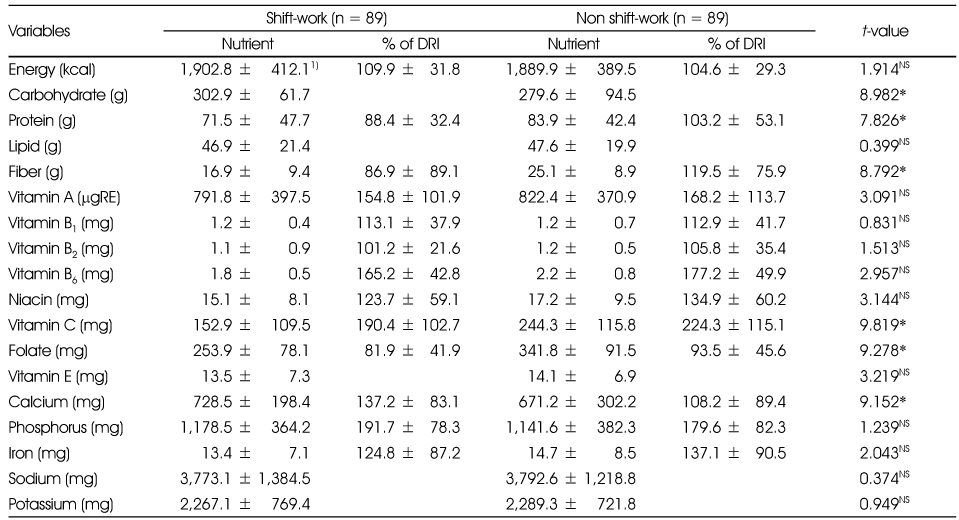References
1. Bae YJ, Kim MH. A study evaluating nutrient intake and diet quality in female college students according to coffee consumption. J Korean Diet Assoc 2009;15(2):128–138.
2. Caruso CC, Lusk SL, Gillespie B. Relationship of work schedules to gastrointestinal diagnoses, symptoms, and medication use in auto factory workers. Am J Ind Med 2004;46(6):586–598.
3. Caruso CC, Rosa RR. Shift work and long work hours. In : Rom WN, ed. Environmental and occupational biomechanics 4th edth ed. Philadelphia: Lippioncott Williams & Wikins; 2007. p. 1539–1563.
4. Choi JH, Choi YJ. Foundation study on a development of barista training program. J Tourism Leis Res 2010;22(6):595–606.
5. Choi SY. Effects of physical environment of barista on job satisfaction and intention of turnover Gwangju: Depart of Hotel Management, Graduate School Honam university; 2010. 6–10.
6. Chun YH. The growth of the service sector and changes in work. Korean J Sociol 2004;38(4):159–186.
7. Chung HK, Kim HY, Lee HY. The antecedents of coffee satisfaction by lifestyle segments for Korean and Chinese university students in Korea. Korean J Community Nutr 2011;16(6):782–793.
8. Kang HJ, Byun KW. Effect of two-year course of food and nutrition on improving nutrition knowledge, dietary attitudes and food habits of junior college female students. Korean J Community Nutr 2010;15(6):750–759.
10. Kim HS, Choi KS, Um MR, Joo YJ. Role of circadian types and depressive mood on sleep quality of shift work nurses. Korean J Psychopharmacol 2011a;22(2):96–104.
11. Kim HY, Hong BY. The trend and causes of income inequality changes among women. Korean J Soc Welf Stud 2009;40(1):87–114.
12. Kim HY, Chung HK, Lee HY. Korean and Chinese university students' importance and performance analysis for quality attributes by coffee type in Daejeon. Korean J Community Nutr 2011b;16(4):511–524.
13. Kim MS, Koo JK. Comparative analysis of food habits and bone density risk factors between normal and risk women living in the Seoul area. Korean J Community Nutr 2008;13(1):125–133.
14. Kim YK. Health status and quality of life in shift-workers Busan: Graduate School of Dong-A University; 2002. 1–18.
15. Korea Centers for Disease Control and Prevention. The third Korea national health and nutrition examine survey (KNHANES III) food frequency questionnaire Seoul: 2006.
16. Korea Centers for Disease Control and Prevention. The forth Korean national health and nutrition examination survey (KNHANES IV) Seoul: 2008. p. 127. p. 143.
17. Korean Nutrition Society. Can-4.0 (Computer Aided Nutrition Analysis Program) Seoul: Korean Nutrition Society; 2010.
19. Knutsson A. Methodological aspects of shift-work research. Chronobiol Int 2004;21(6):1037–1047.
20. Jeon MS, Park OJ. The influence of the physical environment of a coffee shop on customer evaluation and satisfaction. Korean J Culinary Res 2011;17(5):42–56.
21. Lee JT, Lee KJ, Park JB, Lee KW, Jang KY. The relationships between shiftwork and sleep disturbance in a university hospital nurses. Korean J Occup Environ Med 2007;19(3):223–230.
22. Lee KJ, Kim JJ. Relationship of shift work to cardiovascular and gastrointestinal symptoms in Korean female workers. Korean J Occup Environ Med 2008;20(4):362–371.
23. Lee SA. A comparative study on dietary habits and health related factors in the shift-work and the day work police men Iksan-si: Graduate School of Wonkwang University; 2009. 16–69.
24. Lee SL. Effect of nutrition education on improving dietary attitudes, food habits and food frequency-female in twenties shift work in gyeonggi area. Korean J Community Nutr 2013;18(1):55–64.
25. Ministry for Health, Welfare and Family Affairs. Health plan 2010 (2006~2010) - 2008 action program : health promotion for industrial empolyees Seoul: 2008. p. 313–318.
26. Ministry of Health and Welfare, Korea Center for Disease Control and Prevention. Korea healthy statistics 2009: Korea national health and health and nutrition examination survey (KNAHANS IV-3) Seoul: 2010.
27. Noh D, Wang JH, Choi HL, Lim SY, Kim KW, Won CW, Choi KJ. The effect of shift work on the level of self-rated health. Korean J Occup Environ Med 2010;22(3):200–209.
28. Puttonen S, Härmä M, Hublin C. Shift work and cardiovascular disease-pathway from circadian stress to morbidly. Scand J Work Environ Health 2010;36(2):96–108.
29. Shin J, Kim SY, Yoon JY. Effect of sustainability management at coffee houses on customers' store image and behavioral intention. Korean J Community Nutr 2012;17(4):494–503.
30. Sim KS, Lee KH. The effect of nutrition education on nutrition knowledge and health improvement in dyslipidemic industrial empolyees. J Korean Diet Assoc 2012;18(1):43–58.
31. Stockman NK, Schenkel TC, Brown JN, Duncan AM. Comparison of energy and nutrient intakes among meals and snacks of adolescent males. Prev Med 2005;41(1):203–210.
32. Wansink B. Environmental factors that increase the food intake and consumption volume of unknowing consumers. Annu Rev Nutr 2004;24:455–479.
33. You HJ. Study of eating habits and food intakes of industrial workers who works day and night Seoul: Graduate School of Kyunghee University; 2010. 4–52.





